Kruger National Park & Beyond, Africa 2005
2-23
October 2005
by
Henry Detwiler & Bob Miller
Bob Miller and I joined our hosts Barry and Margie Hawthorne of Cape
Town
for a whirlwind 3-week tour of South Africa. This is a summary of
our adventures.
445
species -- bird list may be viewed by clicking > BIRD LIST
Click on
thumbnail pictures for full-sized photos. 
| We spent five days at Kruger National Park, sampling
the varied and beautiful bird and mammal life. Kruger is about the
size of Massachusetts, and completely surrounded by a stout fence (to
keep elephants from trampling surrounding farmland, etc.). We saw
several herds of zebras, some at waterholes, others wandering around
the bush. Since it was the spring, the summer rains had not yet begun,
concentrating many of the mammals at the few remaining ponds and
waterholes.
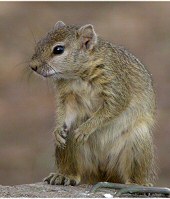
Tree Squirrel with an
attitude |
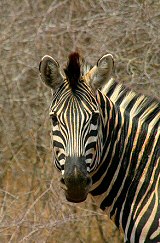
Zebra
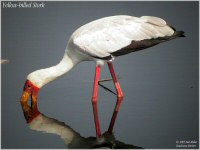
Yellow-billed Stork
|
|
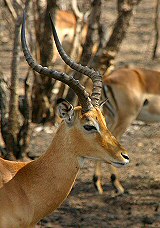
Impala
Ground Hornbills are declining in
numbers at Kruger, but we were fortunate to see two small parties
of these huge hornbills. |
Impalas are the most common antelope in Kruger, numbering in the
hundreds of thousands, and comprise the largest food source for the
feline predators. We saw hundreds of these graceful creatures.

Ground Hornbill
|
|
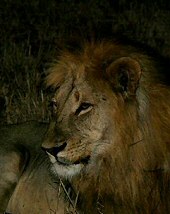
Lion
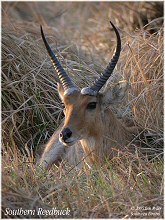
Southern Reedbuck
|
Over the course of our stay we saw thirteen lions;
the first was just as we entered the park, when a female came
strolling down the center of the Crocodile River. The male at
the left was part of a pride of seven that our night guide found in
a circle next to the road. One exciting experience happened
when Bob spotted a lion stalking a waterbuck--it broke off after a
half-hearted lunge--perhaps because lions aren't supposed to eat
waterbuck anyway (bad tasting).
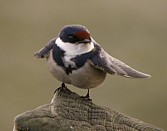
White-throated Swallow
|
|
We spent our nights at two different camps in Kruger. At the
Satara Camp I found this Agami tree lizard, a
colorful beast that looked mighty fearsome. Along one of the
rivers in the park we spotted this water monitor searching out
dinner.
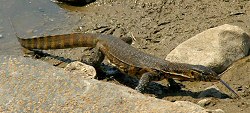
Water Monitor
|
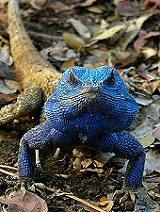
Agami Tree Lizard
|
|
|
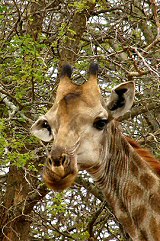
Giraffe |
A mighty odd looking creature is the long-necked giraffe. We
watched one pair of males "battling" it out in a shoving
match, and then slamming their necks into each other. This went on
for ten minutes with neither giving any ground--so we moved on.
The individual on the left was its neck to good advantage, enjoying a meal of leaves
from high up in the tree. |
|
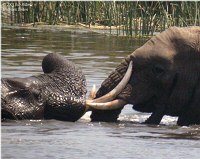
African Elephants
At one of the few remaining lakes
(it was the end of the dry season), we watched as two elephants
played in the water, pushing each other around, and snorkeling with
their trunks as they swam about. From the edge of the water, a
Fish Eagle scanned for its next meal. |

African Fish Eagle |
|
There were lots of crocs in Kruger, especially in the (you guessed
it) Crocodile River. We never saw any of them take any prey,
but then we never saw any skinny ones, either.
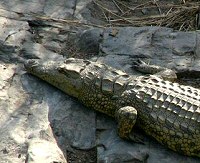
Nile Crocodile
|

White Rhinoceros
A real treat for me was my first wild rhinos. Bob spotted
the first pair about a quarter of a mile away; a most unsatisfactory
look. Then, just down the road, this pair came ambling
across the road right in front of us! They were huge beasts, and I
could picture them using our SUV as a soccer ball.
|
|
One of the many perks of traveling with Barry & Margie was getting
to visit their friends, many of them renown birders & naturalists.
At Warwick Tarboton's ranch we talked birds & dragonflies,
toured his "dragon" pond, and
spotted our only scalyfeathered finches with their Fu-Manchu
moustaches. We also saw lots more of those beautiful Blue
Waxbills. Later that evening, we not only got to watch a
pair of acrobatic Lesser Bushbabies "flying" from tree to tree, we
got to feed them mealworms!

Red-winged Dropwing |
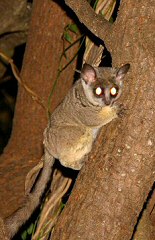
Lesser Bushbaby
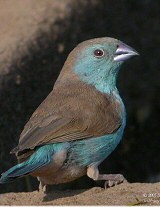
Blue Waxbill
|
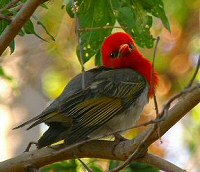
Red-headed Weaver
Our hosts at Dinonyane prepared some fine meals, which we ate
out on the veranda during the daylight hours. Their
gardens & ponds hosted damselflies, dragonflies, frogs, and a
wealth of avian species like tinkerbirds, Royal Flycatchers,
thrushes, weavers, doves, titbabblers, and sunbirds. |
We spent the last couple of nights at the
beautiful Dinonyane Lodge, close to the Nylsvley Nature
Preserve. Right next to their entry way, this spectacular
Red-headed Weaver was alternately
building its nest and displaying to its mate.
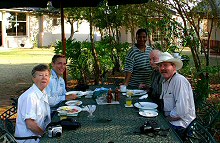
Margie, Henry, Barry & Bob - Dinonyane Lodge |
|
|
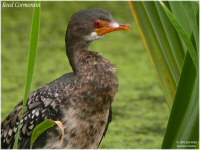
Reed Cormorants
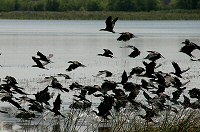 |
On our final day of African birding we stopped at a
large lake north of Pretoria. Here we saw our largest water
monitor yet, and ended our birding quest with beautiful looks at
White-faced Ducks, shorebirds, a huge flock of Reed Cormorants, a
our largest Water Monitor to that date. The whole trip was a
naturalist's adventure we'll never forget!
|
BACK to PAGE 1 |